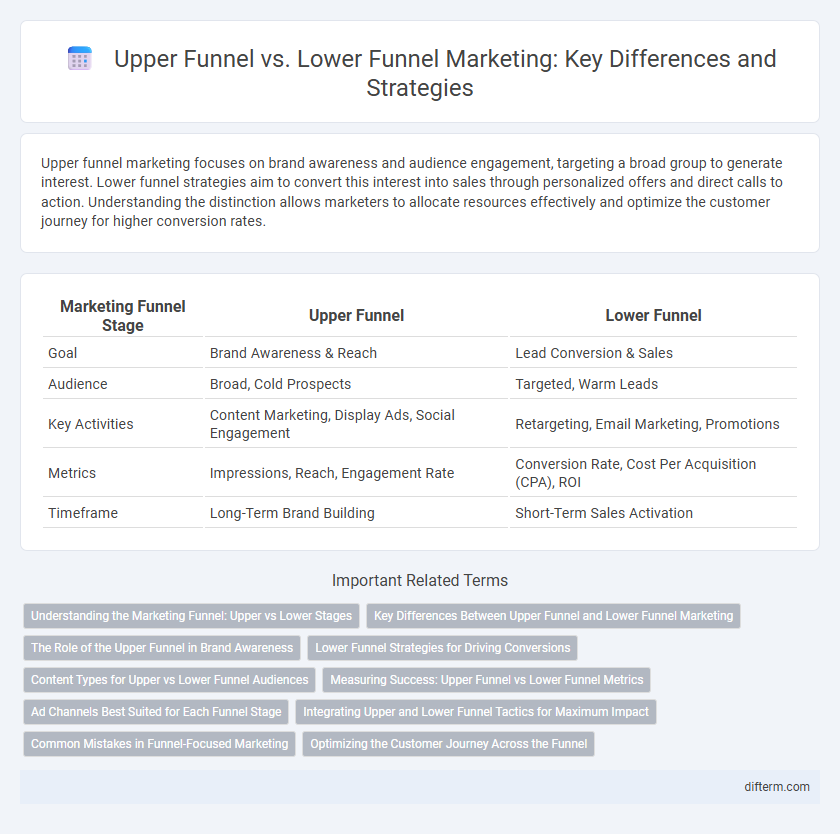Upper funnel marketing focuses on brand awareness and audience engagement, targeting a broad group to generate interest. Lower funnel strategies aim to convert this interest into sales through personalized offers and direct calls to action. Understanding the distinction allows marketers to allocate resources effectively and optimize the customer journey for higher conversion rates.
Table of Comparison
| Marketing Funnel Stage | Upper Funnel | Lower Funnel |
|---|---|---|
| Goal | Brand Awareness & Reach | Lead Conversion & Sales |
| Audience | Broad, Cold Prospects | Targeted, Warm Leads |
| Key Activities | Content Marketing, Display Ads, Social Engagement | Retargeting, Email Marketing, Promotions |
| Metrics | Impressions, Reach, Engagement Rate | Conversion Rate, Cost Per Acquisition (CPA), ROI |
| Timeframe | Long-Term Brand Building | Short-Term Sales Activation |
Understanding the Marketing Funnel: Upper vs Lower Stages
Upper funnel marketing concentrates on brand awareness and audience engagement through broad, attention-grabbing campaigns across social media, display ads, and content marketing. Lower funnel strategies target conversion and sales by using retargeting, personalized offers, and direct calls-to-action to nurture leads and close purchases. Effective marketing funnels integrate both stages to drive customer acquisition and maximize ROI.
Key Differences Between Upper Funnel and Lower Funnel Marketing
Upper funnel marketing targets brand awareness and audience engagement through broad-reach channels like social media, content marketing, and display ads to attract potential customers early in the buying cycle. Lower funnel marketing focuses on conversion-driven tactics such as email retargeting, personalized offers, and search engine marketing (SEM) aimed at prospects ready to make a purchase decision. The key differences lie in their objectives, metrics, and tactics: upper funnel prioritizes reach and impressions, while lower funnel emphasizes conversion rates and return on ad spend (ROAS).
The Role of the Upper Funnel in Brand Awareness
The upper funnel plays a critical role in increasing brand awareness by targeting a broad audience with engaging content that introduces the brand and its values. It leverages channels like social media, display advertising, and video marketing to create initial interest and shape consumer perceptions. This stage lays the foundation for nurturing potential customers towards consideration and eventual conversion in the lower funnel.
Lower Funnel Strategies for Driving Conversions
Lower funnel strategies prioritize converting engaged prospects into customers through targeted tactics such as personalized email marketing, retargeting ads, and limited-time offers. These approaches leverage data-driven insights to deliver highly relevant content, optimizing conversion rates and maximizing return on investment. Focusing on lower funnel activities ensures efficient allocation of budget toward actions that directly influence purchase decisions and drive measurable revenue growth.
Content Types for Upper vs Lower Funnel Audiences
Upper funnel content focuses on brand awareness and audience engagement through formats like blog posts, social media updates, and educational videos that introduce potential customers to products or services. Lower funnel content targets conversion-ready audiences with case studies, product demos, and customer testimonials that address specific pain points and encourage purchase decisions. Tailoring content types to each funnel stage maximizes marketing effectiveness by aligning messaging with audience intent and readiness to buy.
Measuring Success: Upper Funnel vs Lower Funnel Metrics
Upper funnel metrics emphasize brand awareness and reach, tracking impressions, website traffic, and social media engagement to gauge campaign visibility. Lower funnel metrics focus on conversion rates, sales, customer acquisition cost, and return on ad spend (ROAS) to measure direct impact on revenue. Effective marketing strategies integrate both sets of metrics to optimize the customer journey from initial interest to final purchase.
Ad Channels Best Suited for Each Funnel Stage
Upper funnel marketing leverages ad channels like social media, display ads, and video platforms to maximize brand awareness and reach broad audiences. Lower funnel efforts prioritize search engine marketing, retargeting ads, and email campaigns to drive conversions and purchase decisions. Understanding the strengths of channels like Facebook and YouTube for awareness versus Google Ads and personalized email for intent leads to more efficient budget allocation and improved ROI.
Integrating Upper and Lower Funnel Tactics for Maximum Impact
Integrating upper funnel tactics like brand awareness campaigns with lower funnel strategies such as targeted conversions enhances overall marketing effectiveness by creating a seamless customer journey. Utilizing data-driven insights to align messaging across channels ensures consistent engagement, increasing the likelihood of conversion from prospects to loyal customers. Combining these approaches maximizes ROI by nurturing leads at every stage of the funnel and accelerating the path to purchase.
Common Mistakes in Funnel-Focused Marketing
Upper funnel marketing often suffers from vague targeting and inconsistent messaging, leading to low brand awareness and engagement. Lower funnel efforts frequently overlook personalization and timely follow-ups, resulting in lost conversions and poor customer retention. Balancing precise audience segmentation with data-driven attribution models enhances overall funnel performance and maximizes ROI.
Optimizing the Customer Journey Across the Funnel
Upper funnel marketing targets broad audience awareness using strategies like content marketing and social media campaigns to attract potential customers. Lower funnel efforts concentrate on conversion tactics such as personalized offers, retargeting ads, and clear calls-to-action to drive purchase decisions. Optimizing the customer journey requires integrating data-driven insights from both funnel stages to deliver a seamless experience that nurtures leads and maximizes ROI.
Upper funnel vs lower funnel Infographic

 difterm.com
difterm.com